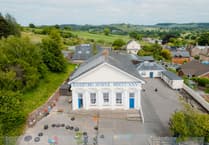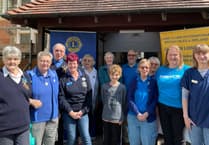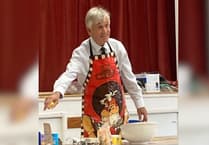MRS Pam Murphy led the Café Church service at Crediton Methodist Church on Palm Sunday, April 2.
We watched a short video dramatisation of Jesus’ triumphal entry into Jerusalem. The road to Jerusalem was crowded with people making their way for Passover - the most important festival in the Jewish calendar.
They were praising God for freeing their people from persecution in Egypt through the Exodus and this is when Jesus chose to make His way into the city.
It sounds like Jesus had pre-arranged with friends to have the colt, a donkey that had never been ridden, ready for His use.
Riding on a donkey was symbolic of a king coming in peace and Jesus was hailed as a king by the people spreading their cloaks on the road and waving palm branches and crying out "Hosannah" – "Save us".
This was especially suitable for the sacred final act that was unfolding before their very eyes. Maybe, this visual demonstration by Jesus riding on a donkey was a way of making an impact on those people whose hearts had not yet been touched by His teaching or those His healing had not yet reached.
What does this story tell us about Jesus?
Firstly, it tells us about Jesus’ courage and determination to fulfil what God, His Father, had commissioned Him to do in the world.
He knew He was going into a city that was hostile to Him. The people on the road were acclaiming Him but the authorities were determined to put an end to His radical actions.
Courageously, Jesus didn’t slip into the city by a back way under the cover of night. He entered with all eyes on Him, defiantly challenging his enemies. Effectively Jesus was saying "do your worst".
Secondly, we see Jesus claiming before both His friends and His enemies the truth of His kingship – He is the Messiah.
This claim to His kingship isn’t about ruling by force or for profit and gain.
Jesus was claiming kingship of our hearts, and coming in peace. Jesus is the king who came and comes in God’s authority to bring peace and justice into people’s lives and to save us all from the power of sin and its consequences over us.
Coming not to destroy – but to love; not to condemn – but to help; not in the might of arms – but in the strength of love.
There have always been bystanders in the crowd as Jesus finally enters Jerusalem. Some wanting more evidence that Jesus is our eternal king. Some standing by hailing Jesus as Lord but unready to step out truly to follow Him.
Then there are those who have stepped onto the Way itself, walking in faith as they follow their Lord in the knowledge that there will be challenges and obstacles and trusting in faith that Jesus leads us more closely to God’s kingdom.
As we thank God for sending Jesus to us, may we commit to the life-long journey ahead, following our Lord and Saviour wherever that takes us.
Before they were handed out, Pam gave a brief history of the Palm Cross.
Way back in the 4th century faithful Christians in Jerusalem began to re-enact Christ’s entry into the city by waving palm branches – as a way of showing honour to Christ.
This practice spread to the church in Rome and on to other places – waving branches of whatever was available – often olive branches and, here in Britain, yew and willow.
During the mid 20th century the idea of making individual crosses from palms began.
In 1965 in Tanzania the Rev Alan Talbot started the African Palms Company where villagers gather wild dwarf palms, strip, dry and split the fronds and make palm crosses just like the ones which were distributed today.
Let these palm crosses be for us signs of His victory. May we hail Him as our King and faithfully follow Him all our lives.
Bronwyn Nott





Comments
This article has no comments yet. Be the first to leave a comment.